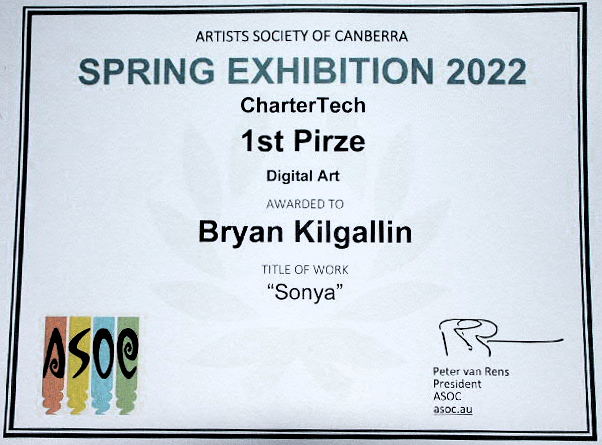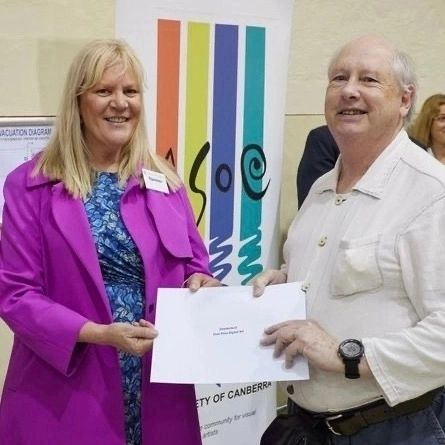My art is contemporary. Such artistic expression is emotive storytelling.
I list the diverse artistic media that I have used. They are in alphabetical order
Above is a navigation menu. You can view examples by clicking a link.

Acrylic
My early art classes used this medium. Acrylic paint dries fast. I experimented with a wide range of media. And I won prizes with synthetic polymer paint.
Artist's statement
This describes my artwork.
I have scored in the top 1% for visuo-spatial aptitude. I am conscientious, and I think abstractly.
I'm autistic, and have obsessive-compulsive tendencies. I was advised to explore art as a form of therapy.
As a Mahayana Buddhist, I seek to improve everyday reality. So I find beauty in the mundane.
I had a professional background in informatics. That led me to work primarily with digital media. I use a pen display to create art. That is via vector graphics software. I'm part of a digital media group. My displays transmit light. So I use them in shaded environments. Occasionally I participate in an urban sketching group. There I focus on interior venues.
My career began in scientific settings. Where I learned the experimental method. This varies my results, as I explore my medium. In which I have developed a distinct style.
Judges liked my having abstracted shapes from a reference. Digital images are easily shared. That is via the Internet. Thus my work reaches a global audience.
Digital Media
This emerged in the second half of last century. Digital art harnesses technology. That expands creative possibilities. Now it is the only medium that I use.

The following subsections are on animation and illustration. They link examples of my artworks.
Animation
This is a filmmaking technique. It shows a succession of frames. Here are my two projects. One simulates a bouncing ball. In my second animation, I used as reference my earlier video. I manually traced its individual frames.
Illustration
Raster graphics

I started with raster graphics, mastering it in two years. The images are resolution dependent. They lose quality when scaled.
Vector graphics
Currently I utilise vector software. That's because it allows me to increase the size of images without compromising resolution. Vector graphics are founded on mathematical formulae. They can be enlarged without reducing quality.
Exhibitions
I've participated in various art clubs. Many of them organised exhibitions. At a few I received awards.
| Year | Title | Venue | Prize |
|---|---|---|---|
| 2003 | Flowers of Hope and Vision | Chapman Gallery | |
| 2004 | Between Surreal and Serene | ACT Legislative Assembly Gallery | Painting |
| 2005 | Inspired By Nature | Canberra Museum and Gallery | |
| 2006 | Moments of In-between | Belconnen Gallery | Exhibition |
| 2007 | Mask | Canberra Contemporary Art Space Manuka | |
| 2008 | Our Dreams | Belconnen Gallery | |
| 2008 | Digital Photography | Belconnen Gallery | |
| 2008-2009 | Painting & Drawing | Belconnen Gallery | |
| 2009 | Alive & Well In Canberra | Belconnen Gallery | |
| 2011 | No Health Without Mental Health | Belconnen Gallery | |
| 2012 | Anything Goes | Belconnen Gallery | |
| 2012 | Opening | Playing Field Studio | |
| 2012 | Mindscapes Festival Art & Photography Competition | Belconnen Gallery | |
| 2014 | Mindscapes Festival Art & Photography Competition | Belconnen Gallery | |
| 2015 | Act Belong Commit | Belconnen Gallery | |
| 2016 | De Fence | Belconnen Arts Centre | |
| 2018 | Piece of Mind | Belconnen Community Gallery | |
| 2018 | Inside/Outside | Belconnen Community Gallery | |
| 2019 | Pigment of the Imagination | Belconnen Community Gallery | |
| 2019 | Making Tracks | Belconnen Community Gallery | |
| 2020 | Canberra Art Workshop | M16 Artspace | |
| 2021 | Canberra Art Workshop | M16 Artspace | |
| 2021 | Testamur 3 2021 | M16 Artspace | |
| 2022 | Canberra Art Workshop | M16 Artspace | |
| 2022 | 80th Spring Exhibition | The Fitters' Workshop | 1st Digital Art |
| 2024 | ASOC Spring Exhibition | The Fitters' Workshop |
I received an award. Of which I was proud.

Following is a chart. It presents the results of my market survey. That was of an art club exhibition.

Both axes are transformed logarithmically. That is to better view and model the data. The regression line shows a positive relationship. That relates to the log-log scales.
So a power law model fits the data. Such a relationship can be expressed as follows.
Here x and y are variables, and a and b are constants.
- y=axb
- log(y) =log(a) + b log(x)
Specifically, larger artworks tend to have higher prices. And this relationship follows a power-law pattern.
Mixed Media
This began in the first quarter of the twentieth century. That was by Dada creators like Marcel Duchamp. They integrated common items and unusual materials into their work. Dada dismissed conventional notions of beauty and structure.
Surrealism evolved from Dada. It emerged as an artistic movement. And it transformed how artists perceived and represented objects. The surrealists sought to unveil hidden psychological depths. Surrealism connected the logical realm with the illogical.
Both movements transformed objects into innovative artistic tools. And they merged various components.
Oils
Oil painting transformed the art of portraiture. Pigments are bound in drying oil, usually linseed. It enables artists to blend hues directly on the canvas. Oil painting offers a range of expressive techniques. Painters can go beyond surface representation. Artists can use layering. They can grade skin tones, create depth, and capture facial details. Thus they enliven a subject. My example portrait epitomises the individual's essence.
Photography
Photography transforms light. So it records a scene.
I studied natural science. So I am drawn to natural subjects. As I am interested in the natural world.
I own an old digital camera. This captures moments quickly. This conveys a sense of immediacy.
I am obsessive-compulsive. So I crop images closely. This emphasises the subject.
Printmaking
Artwork can be created using traditional manual relief printing onto paper. Thereby the artist carves into a matrix. Thus they remove the non-image areas. Matrix materials include wood, metal, stone, and linoleum. The design is left in relief. Ink is then applied to the raised surface of the matrix. Next the inked matrix is pressed onto paper. So the ink from the raised areas transfers. This produces the print.
Watercolour
Watercolour paint is made of pigments suspended in water. The linked page shows a watercolour painting class. That art group excursion was outdoors.